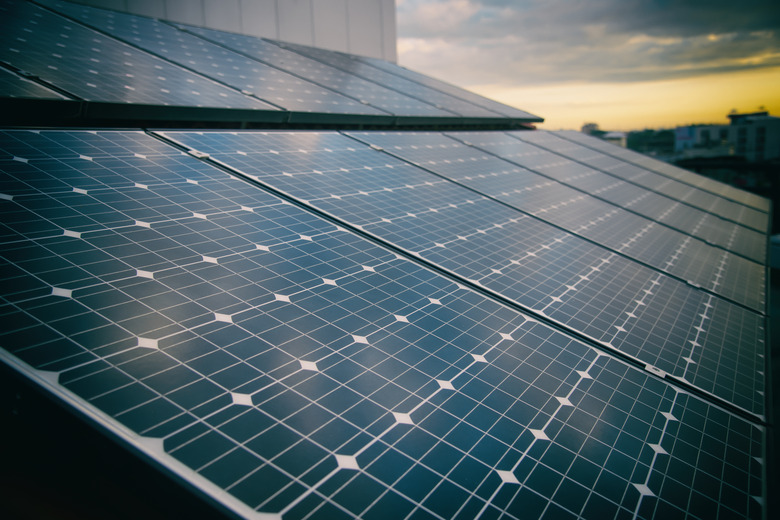What Kind Of Light Does A Solar Cell Need?
Solar radiation in the red to violet wavelengths blast a solar cell with enough energy to create electricity. But solar cells do not respond to all forms of light. Wavelengths in the infrared spectrum have too little of the energy needed to jostle electrons loose in the solar cell's silicon, the effect that produces electric current. Ultraviolet wavelengths have too much energy. These wavelengths simply create heat, which can reduce a cell's efficiency. Solar cells require certain wavelengths in the light spectrum to generate useful amounts of electricity.
Anatomy of a Solar Cell
Anatomy of a Solar Cell
A solar, or photovoltaic, cell is a two-layer sandwich of silicon; one layer, called N-type, contains traces of elements such as arsenic to give the material a negative electric charge; the second layer, called P-type, is laced with other elements that give a positive charge. Electrically, the two sides act like the terminals of a battery; when connected to a circuit, an electric current flows from the positive side, through the circuit components and to the solar cell's negative side. Some solar cells use silicon in crystal form; others use an amorphous, or glass-like, silicon. Crystalline silicon tends to be more efficient at converting light but costs more than the amorphous type.
Effect of Brightness
Effect of Brightness
Brightness or luminosity is the amount of light that shines on a solar cell. In total darkness, a cell produces no electricity. As the amount of light increases, so does the cell's current. At a certain level of brightness, however, the cell's output reaches a limit; beyond this point, more light gives no additional current. A solar cell's specifications include a nominal voltage and current rating which is the cell's output under direct bright sunshine. To get the most output from a solar cell, it's important to face it towards the sun as directly as possible. A solar panel installer, for example, will mount a panel at an angle that catches most of the sun's rays. The angle depends on where you're located on the earth: the farther north or south you are from the equator, the steeper the angle. Some solar power "farms" have panels on a mechanism that tilts, tracking the sun's daily movement in the sky.
Spectrum, Wavelength and Color
Spectrum, Wavelength and Color
Visible light is part of the electromagnetic spectrum, a form of energy that also includes radio waves, ultraviolet and X-rays. The colors of the rainbow contained in visible light represent different wavelengths; the wavelength of the color red, for example, is about 700 nanometers, or billionths of a meter, and 400 nanometers is the wavelength for violet. Solar cells respond to many of the same wavelengths detected by the human eye.
Sunlight or Artificial Light
Sunlight or Artificial Light
Solar cells generally work well with natural sunlight, as most uses for solar-powered devices are outdoors or in space. Because artificial sources of light such as incandescent and fluorescent bulbs mimic the Sun's spectrum, solar cells can also work indoors, powering small devices such as calculators and watches. Other artificial sources such as lasers and neon lamps have very restricted color spectra; solar cells may not work as effectively with their light.
Cite This Article
MLA
Papiewski, John. "What Kind Of Light Does A Solar Cell Need?" sciencing.com, https://www.sciencing.com/kind-light-solar-cell-need-21539/. 9 March 2018.
APA
Papiewski, John. (2018, March 9). What Kind Of Light Does A Solar Cell Need?. sciencing.com. Retrieved from https://www.sciencing.com/kind-light-solar-cell-need-21539/
Chicago
Papiewski, John. What Kind Of Light Does A Solar Cell Need? last modified March 24, 2022. https://www.sciencing.com/kind-light-solar-cell-need-21539/
